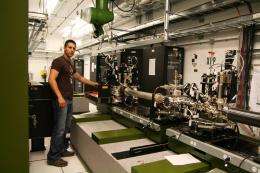XPP instrument blasts past key milestones

(PhysOrg.com) -- The X-ray Pump Probe instrument at the Linac Coherent Light Source is installed and ready for its first user experiments several weeks ahead of schedule, thanks in part to funds provided by the American Recovery and Reinvestment Act.
The instrument will take advantage of the ultrafast X-ray pulses delivered by the LCLS beam to observe important chemical and biological processes, including the photosynthetic generation of chemical energy and the atomic-scale dynamics of proteins.
The XPP project received more than 40 percent of its funding from the Recovery Act, "which helped allow completion of most of the final instrument configuration in time for the first user experiments in mid-October," said LCLS Ultrafast Scientific Instrument project manager Tom Fornek.
The first of two XPP installation phases, called the "Early Science" milestone, was scheduled to be completed on October 19 and included the commissioning of several components that would provide a basic instrument for the first user runs.
Additional capabilities weren't planned until early 2011, but the instrument team was able to incorporate them into the early science installations, which they completed on August 27. These final components included a reference laser, X-ray focusing lenses and a monochromator.
"Infusion of Recovery Act funds enabled this project to not only deliver the XPP earlier than planned but to enhance its capabilities for early experiments," said Hannibal Joma, the Federal Project Director at SLAC's Department of Energy site office. "Next generation instruments such as XPP are of high priority to the DOE Office of Science because they provide the functionalities required to address grand scientific challenges."
XPP experiments will use an optical laser pulse to stimulate biological, chemical and physical transformations on the atomic scale—changes that involve the motions of electrons, atoms and molecules over billionths of a meter and quadrillionths of a second. As precisely timed femtosecond X-ray pulses hit the optically excited samples, scattering patterns can be used to determine photo-induced changes and new molecular structures with unprecedented detail.
When the first XPP users arrive this fall, they will be able to conduct experiments with much more than a basic instrument, which XPP instrument scientist David Fritz said "will enhance our chance of success."
Provided by SLAC National Accelerator Laboratory





















